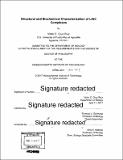Structural and biochemical characterization of LINC complexes
Author(s)
Cruz Ruiz, Victor E. (Victor Emmanuel Cruz Ruiz)
DownloadFull printable version (17.65Mb)
Other Contributors
Massachusetts Institute of Technology. Department of Biology.
Advisor
ThomasU. Schwartz.
Terms of use
Metadata
Show full item recordAbstract
The nuclear envelope (NE) is comprised of a double membrane bilayer that physically separates the nucleoplasm from the cytoplasm. Information can be transmitted through the NE by molecular exchange through the nuclear pore complex (NPC) and by transduction of mechanical forces mediated by the linker of nucleoskeleton to cytoskeleton (LINC) complexes. LINC complexes are composed of two proteins. The nuclear half is formed by SUN proteins and the cytoplasmic half by KASH-peptide containing proteins. Each KASH protein interacts with different elements of the cytoskeleton and serve a distinct function. What dictates the pairing of the diverse repertoire of SUN- and KASH-proteins? Mechanistic details on the regulation of SUNKASH interactions have so far remained largely elusive. To address this problem, we have solved high resolution X-ray crystal structures of SUN2 in complex with various KASH peptides. These structures revealed two distinct binding modes between SUN and KASH. Sequence analysis can be used to distinguish between these alternative binding modes. Additional biochemical characterization showed that SUN trimers can bind up to three different KASH peptides simultaneously, adding an unexpected layer of complexity to LINC complexes. A hallmark of SUN proteins is the elongated coiled-coil domain that precedes the SUN domain. This coiled-coil domain likely spans the width of the perinuclear space (PNS) and may be involved in mediating higher order assemblies of LINC complexes. We have extensively characterized the oligomeric state of the coiled-coil domain in solution, and have mapped the regions that are critical for trimerization. We believe that the best strategy moving forward is to structurally characterize the coiled-coil of SUN proteins, to which I have contributed important initial results. The cytoplasmic domains of KASH proteins, also known as Nesprins, physically anchor the outer nuclear membrane (ONM) with various cytoskeletal proteins. Nesprin- 2, for example, directly binds to actin through its N terminus and indirectly through interactions with other actin binding proteins. Nesprin-2 actin complexes are required for nuclear nuclear polarization during fibroblast migration. I have started to characterize the interactions between Nesprin-2 and FHOD1, as well as Fascin-1, both well known actin binders. Additionally, I have initiated the X-ray crystallographic analysis to obtain a detailed structural understanding of these complexes and provide detailed insight into the pathologies associated with aberrant interactions.
Description
Thesis: Ph. D., Massachusetts Institute of Technology, Department of Biology, 2017. Cataloged from PDF version of thesis. Includes bibliographical references.
Date issued
2017Department
Massachusetts Institute of Technology. Department of BiologyPublisher
Massachusetts Institute of Technology
Keywords
Biology.